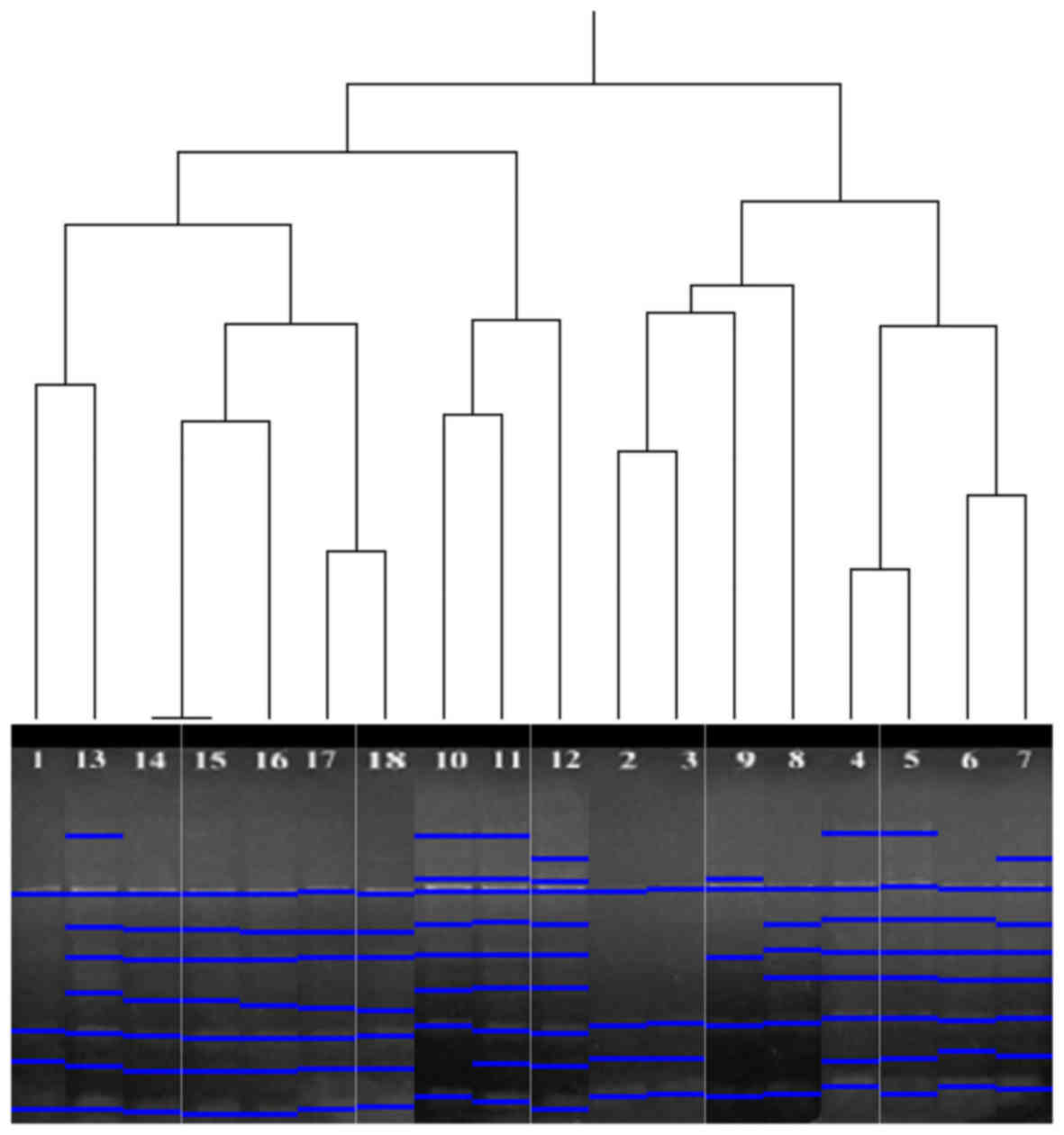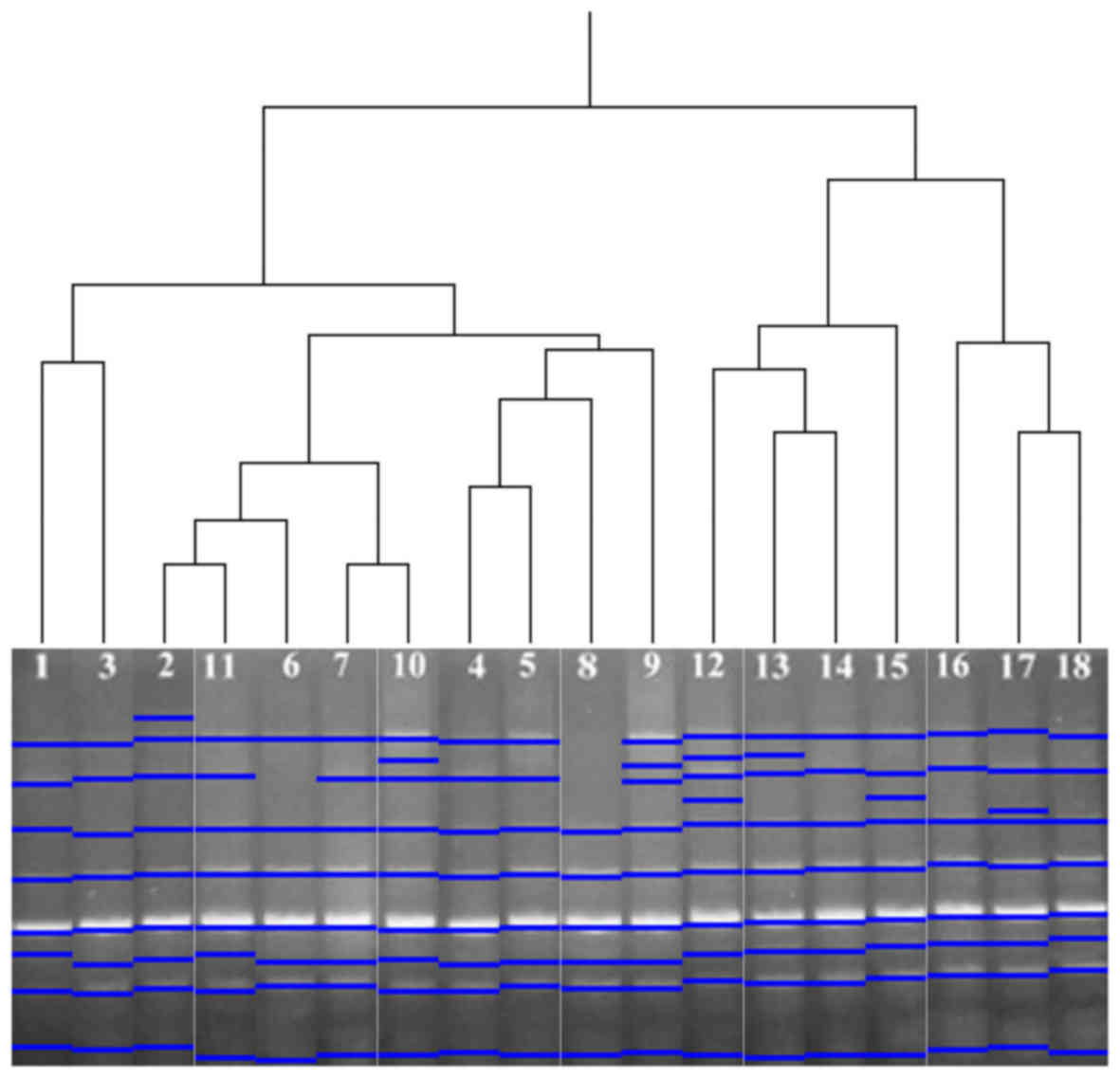|
1
|
Perron H and Lang A: The human endogenous
retrovirus link between genes and environment in multiple sclerosis
and in multifactorial diseases associating neuroinflammation. Clin
Rev Allergy Immunol. 39:51–61. 2010. View Article : Google Scholar : PubMed/NCBI
|
|
2
|
Subramanian RP, Wildschutte JH, Russo C
and Coffin JM: Identification, characterization, and comparative
genomic distribution of the HERV-K (HML-2) group of human
endogenous retroviruses. Retrovirology. 8:902011. View Article : Google Scholar : PubMed/NCBI
|
|
3
|
Downey RF, Sullivan FJ, Wang-Johanning F,
Ambs S, Giles FJ and Glynn SA: Human endogenous retrovirus K and
cancer: Innocent bystander or tumorigenic accomplice? Int J Cancer.
137:1249–1257. 2015. View Article : Google Scholar : PubMed/NCBI
|
|
4
|
Gonzalez-Cao M, Iduma P, Karachaliou N,
Santarpia M, Blanco J and Rosell R: Human endogenous retroviruses
and cancer. Cancer Biol Med. 13:483–488. 2016. View Article : Google Scholar : PubMed/NCBI
|
|
5
|
Hurst TP and Magiorkinis G: Epigenetic
control of human endogenous retrovirus Expression: Focus on
regulation of long-terminal repeats (LTRs). Viruses. 9:92017.
View Article : Google Scholar
|
|
6
|
Kremer D, Glanzman R, Traboulsee A, Nath
A, Groc L, Horwitz M, Göttle P, Perron H, Gold J, Hartung HP, et
al: Prehistoric enemies within: The contribution of human
endogenous retroviruses to neurological diseases. Meeting report:
‘Second International Workshop on Human Endogenous Retroviruses and
Disease’, Washington DC, March 13th and 14th 2017. Mult Scler Relat
Disord. 15:18–23. 2017. View Article : Google Scholar : PubMed/NCBI
|
|
7
|
Griffiths DJ: Endogenous retroviruses in
the human genome sequence. Genome Biol. 2:S10172001. View Article : Google Scholar
|
|
8
|
Kalendar R, Grob T, Regina M, Suoniemi A
and Schulman A: IRAP and REMAP: Two new retrotransposon-based DNA
fingerprinting techniques. Theor Appl Genet. 98:704–711. 1999.
View Article : Google Scholar
|
|
9
|
Gozukirmizi N, Yilmaz S, Marakli S and
Temel A: Retrotransposon-based molecular markers; Tools for
variation analysis in plantsApplications of Molecular Markers in
Plant Genome analysis and Breeding. Taski-Ajdukovic K: Research
Signpost; Kerala: pp. 19–45. 2015
|
|
10
|
Cakmak B, Marakli S and Gözükirmizi N:
Sukkula retrotransposon movements in the human genome. Biotechnol
Biotechnol Equip. 31:900–905. 2017.
|
|
11
|
Guliyev M, Yılmaz S, Şahin K, Maraklı S
and Gözükirmizi N: Human endogenous retrovirus-H insertion
screening. Mol Med Rep. 7:1305–1309. 2013. View Article : Google Scholar : PubMed/NCBI
|
|
12
|
Jaccard P: Nouvelles recherches sur la
distribution florale. Bull Soc Vaud Sci Nat. 44:223–270. 1908.
|
|
13
|
Heras J, Domínguez C, Mata E, Pascual V,
Lozano C, Torres C and Zarazaga M: GelJ - a tool for analyzing DNA
fingerprint gel images. BMC Bioinformatics. 16:2702015. View Article : Google Scholar : PubMed/NCBI
|
|
14
|
Sverdlov ED: Retroviruses and primate
evolution. BioEssays. 22:161–171. 2000. View Article : Google Scholar : PubMed/NCBI
|
|
15
|
van de Lagemaat LN, Landry JR, Mager DL
and Medstrand P: Transposable elements in mammals promote
regulatory variation and diversification of genes with specialized
functions. Trends Genet. 19:530–536. 2003. View Article : Google Scholar : PubMed/NCBI
|
|
16
|
Kazazian HH Jr: Mobile elements: Drivers
of genome evolution. Science. 303:1626–1632. 2004. View Article : Google Scholar : PubMed/NCBI
|
|
17
|
Seifarth W, Spiess B, Zeilfelder U, Speth
C, Hehlmann R and Leib-Mösch C: Assessment of retroviral activity
using a universal retrovirus chip. J Virol Methods. 112:79–91.
2003. View Article : Google Scholar : PubMed/NCBI
|
|
18
|
Mamedov I, Lebedev Y, Hunsmann G,
Khusnutdinova E and Sverdlov E: A rare event of insertion
polymorphism of a HERV-K LTR in the human genome. Genomics.
84:596–599. 2004. View Article : Google Scholar : PubMed/NCBI
|
|
19
|
Kahyo T, Yamada H, Tao H, Kurabe N and
Sugimura H: Insertionally polymorphic sites of human endogenous
retrovirus-K (HML-2) with long target site duplications. BMC
Genomics. 18:4872017. View Article : Google Scholar : PubMed/NCBI
|
|
20
|
Belshaw R, Dawson ALA, Woolven-Allen J,
Redding J, Burt A and Tristem M: Genomewide screening reveals high
levels of insertional polymorphism in the human endogenous
retrovirus family HERV-K(HML2): Implications for present-day
activity. J Virol. 79:12507–12514. 2005. View Article : Google Scholar : PubMed/NCBI
|
|
21
|
Lee E, Iskow R, Yang L, Gokcumen O,
Haseley P, Luquette LJ III, Lohr JG, Harris CC, Ding L, Wilson RK,
et al: Cancer Genome Atlas Research Network: Landscape of somatic
retrotransposition in human cancers. Science. 337:967–971. 2012.
View Article : Google Scholar : PubMed/NCBI
|
|
22
|
Marchi E, Kanapin A, Magiorkinis G and
Belshaw R: Unfixed endogenous retroviral insertions in the human
population. J Virol. 88:9529–9537. 2014. View Article : Google Scholar : PubMed/NCBI
|
|
23
|
Wildschutte JH, Williams ZH, Montesion M,
Subramanian RP, Kidd JM and Coffin JM: Discovery of unfixed
endogenous retrovirus insertions in diverse human populations. Proc
Natl Acad Sci USA. 113:E2326–E2334. 2016. View Article : Google Scholar : PubMed/NCBI
|
|
24
|
Shin W, Lee J, Son SY, Ahn K, Kim HS and
Han K: Human-specific HERV-K insertion causes genomic variations in
the human genome. PLoS One. 8:e606052013. View Article : Google Scholar : PubMed/NCBI
|
|
25
|
Kano H, Godoy I, Courtney C, Vetter MR,
Gerton GL, Ostertag EM and Kazazian HH Jr: L1 retrotransposition
occurs mainly in embryogenesis and creates somatic mosaicism. Genes
Dev. 23:1303–1312. 2009. View Article : Google Scholar : PubMed/NCBI
|
|
26
|
Vogel G: The human genome. Objection #2:
Why sequence the junk? Science. 291:11842001. View Article : Google Scholar : PubMed/NCBI
|
|
27
|
Li M, Radvanyi L, Yin B, Li J, Chivukula
R, Lin K, Lu Y, Shen J, Chang DZ, Li D, et al: Down-regulation of
human endogenous retrovirus type K (HERV-K) viral env RNA in
pancreatic cancer cells decreases cell proliferation and tumour
growth. Clin Cancer Res. 23:5892–5911. 2017. View Article : Google Scholar : PubMed/NCBI
|
|
28
|
Maze E, Reeves S, Hilton D, Provenzano L,
Belshaw R and Ammoun S: Abstract 4627: The role of human endogenous
retroviral proteins in the development of Merlin-deficient tumors
and as potential drug targets. In: Proceedings of the AACR 107th
Annual Meeting 2016, New Orleans, LA. Cancer Res. 76 Suppl
14:Abstract nr 4627. 2016.
|
|
29
|
Suntsova M, Gogvadze EV, Salozhin S,
Gaifullin N, Eroshkin F, Dmitriev SE, Martynova N, Kulikov K,
Malakhova G, Tukhbatova G, et al: Human-specific endogenous
retroviral insert serves as an enhancer for the
schizophrenia-linked gene PRODH. Proc Natl Acad Sci USA.
110:19472–19477. 2013. View Article : Google Scholar : PubMed/NCBI
|
|
30
|
Bergallo M, Montanari P, Mareschi K,
Merlino C, Berger M, Bini I, Daprà V, Galliano I and Fagioli F:
Expression of the pol gene of human endogenous retroviruses HERV-K
and -W in leukemia patients. Arch Virol. 162:3639–3644. 2017.
View Article : Google Scholar : PubMed/NCBI
|
|
31
|
Iskow RC, McCabe MT, Mills RE, Torene S,
Pittard WS, Neuwald AF, Van Meir EG, Vertino PM and Devine SE:
Natural mutagenesis of human genomes by endogenous
retrotransposons. Cell. 141:1253–1261. 2010. View Article : Google Scholar : PubMed/NCBI
|













